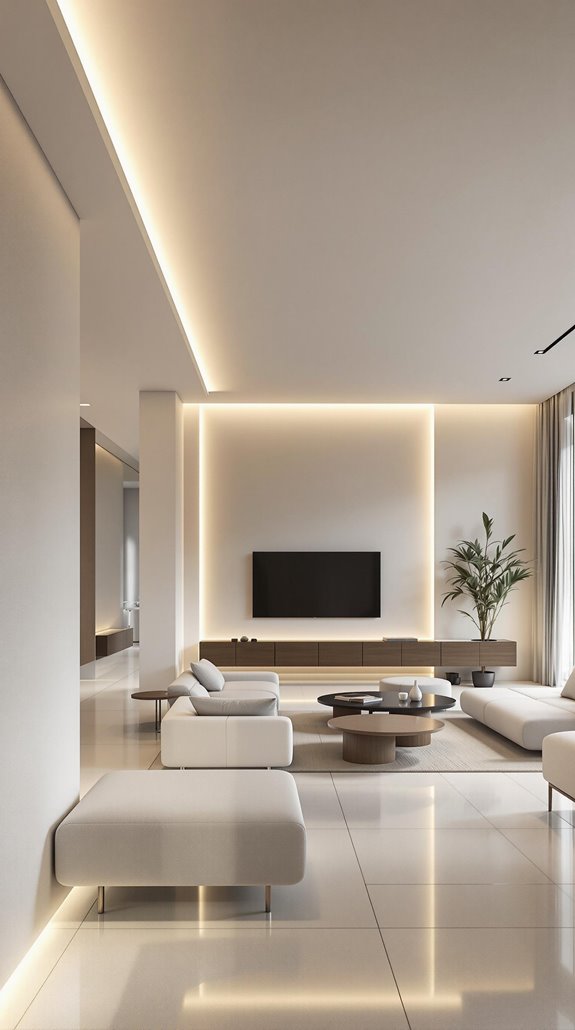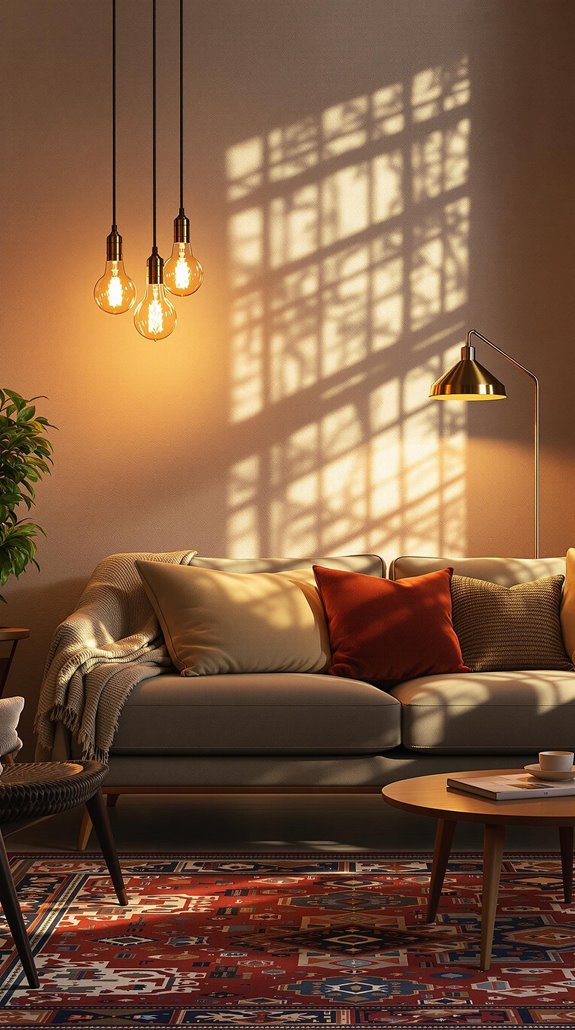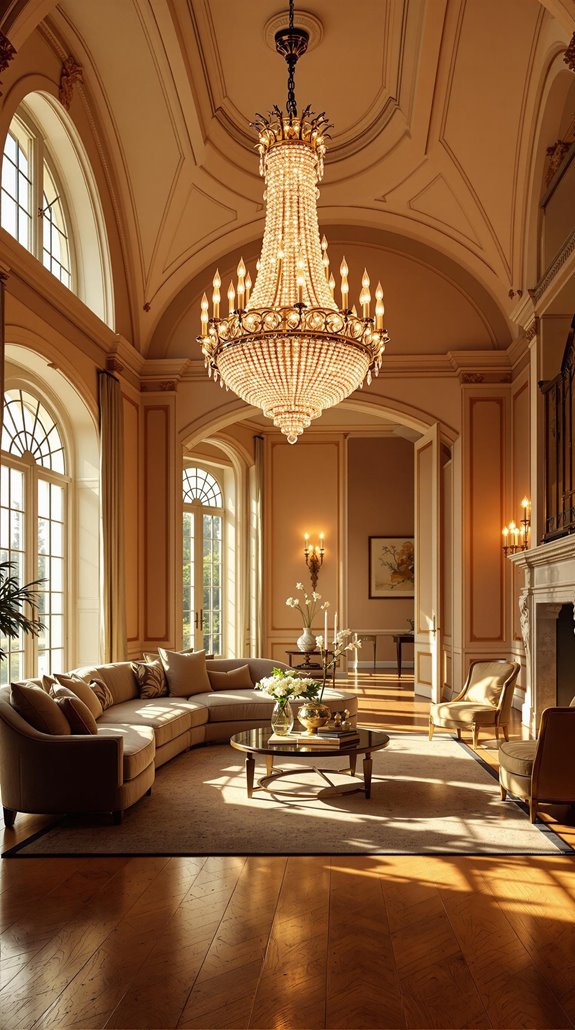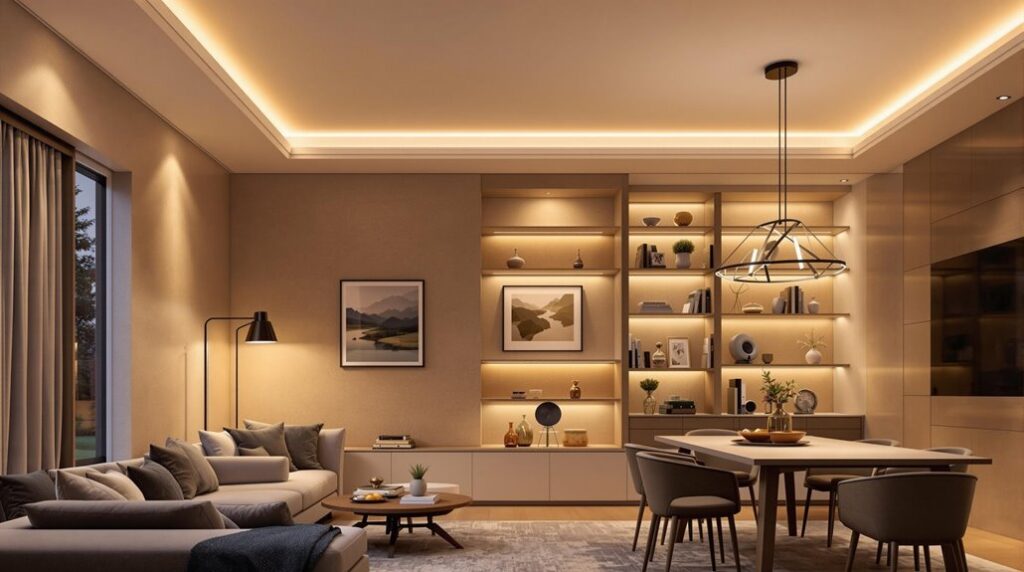I’ve spent years watching homeowners struggle with lighting that fails to capture their vision, and I can tell you the difference between good and transformative design comes down to understanding nine key principles. Whether you’re planning a complete renovation or simply want to refresh your current space, these proven strategies will help you create lighting that doesn’t just illuminate—it elevates every corner of your home in ways you haven’t considered.
Key Takeaways
- Choose natural materials like bamboo, rattan, and wood for authentic warmth that complements both rustic and contemporary design styles.
- Install oversized statement chandeliers as focal points, sizing them to one-third of your room’s width for perfect proportional balance.
- Integrate smart LED systems with app or voice control to mimic natural light patterns while optimizing energy efficiency.
- Create seamless ambiance using invisible lighting systems like cove lighting and recessed linear fixtures for clean, modern aesthetics.
- Blend vintage-inspired fixtures with contemporary elements using warm 2700K-3000K bulbs for timeless character and cozy atmosphere.
Embrace Natural and Organic Materials for Warm Ambiance

When you’re selecting lighting fixtures for your next project, natural and organic materials offer the most effective path to creating warm, inviting spaces that feel authentically connected to nature. I recommend prioritizing wood, bamboo, rattan, and seagrass fixtures that showcase unique grain patterns and textures. These materials work seamlessly across design styles—from rustic farmhouse to contemporary minimalist—ensuring your lighting choices won’t clash with future decor updates.
For maximum impact, choose fixtures with woven elements or rough-hewn surfaces that add dimensional depth. Mixed-material combinations like wood-and-glass create striking contrast while maintaining organic appeal. Focus on pieces featuring earth tones and soft, diffused lighting that replicates natural daylight quality. You’ll achieve spaces that feel both sophisticated and genuinely welcoming to family and guests. Additionally, consider integrating sustainable materials that not only enhance the aesthetic but also contribute to an eco-friendly home environment.
Consider incorporating recycled glass fixtures that add distinctive character while supporting environmental sustainability through waste reduction.
Make a Statement With Sculptural Lighting Fixtures
Sculptural lighting fixtures transform ordinary rooms into curated gallery spaces where functionality meets artistic expression. I’ve noticed how these statement pieces create instant focal points while delivering essential illumination. You’ll find geometric designs with clean lines perfectly complement minimalist interiors, while organic shapes inspired by nature add warmth to contemporary spaces.
When selecting sculptural fixtures, I recommend considering your room’s proportions first. Oversized chandeliers work beautifully in large living areas, but cozy reading nooks need smaller table lamps that double as art pieces. The quiet luxury trend emphasizes timeless, beautifully crafted pieces with simple materials that’ll remain stylish for years.
I always suggest choosing dimmable options—they let you adjust from task lighting to ambient mood setting, maximizing your investment in these collectible pieces. The earliest chandeliers actually trace back to around 17,000 BCE in Lascaux caves, showing how humans have long understood the power of elevated lighting to transform spaces.
Achieve Clean Lines With Minimalist Integration

As modern interiors increasingly embrace minimalist aesthetics, achieving clean lines through thoughtful lighting integration requires strategic planning and deliberate restraint. I recommend starting with one or two fixture replacements to test your minimalist vision before committing to a complete overhaul.
Choose well-crafted lights with simple, elegant, and robust design—avoid overly decorative or fussy options that compete with your space’s tranquility. Select fixtures that complement your existing decor while adhering to minimalist principles of geometric shapes and neutral palettes. Focus on clear lines and natural materials to create lighting that truly serves as the focal point of your space. Incorporating eco-friendly materials into your lighting choices can enhance both the design and sustainability of your home.
Don’t over-light every corner; leave empty spaces to celebrate the minimalist aesthetic. Combine ambient, task, and accent lighting layers for balanced functionality, then install dimmer switches to adjust mood and intensity, enhancing your home’s flexibility and ambiance.
Explore Innovative Materials and Smart Technology
Today’s lighting landscape offers unprecedented opportunities to merge cutting-edge materials with intelligent technology systems that transform how we illuminate our spaces. I’ve found that smart bulbs now mimic natural light patterns, automatically adjusting brightness and color temperature throughout your day to support healthy circadian rhythms. Additionally, it’s crucial to ensure clear communication with your suppliers to avoid delays in obtaining these innovative products.
You can integrate bamboo fixtures with dimmable LED systems, creating sustainable pieces that respond to voice commands or smartphone controls. Ultra-thin flexible panels allow installation on curved surfaces, while fractal glass creates mesmerizing light patterns that shift with smart programming. I recommend combining recycled glass fixtures with automated dimming technology – you’ll reduce environmental impact while enjoying personalized lighting scenes. These innovative materials paired with smart controls deliver both functional performance and the sophisticated aesthetic we’re all seeking in modern home design. Advanced sensors will help optimize energy consumption by detecting occupancy and ambient light levels, ensuring your lighting systems only use power when needed.
Revive Retro and Vintage Styles With Modern Touches

While cutting-edge materials and smart technology reshape contemporary lighting, vintage-inspired fixtures bring timeless character back into modern spaces. I’ve found that mid-century modern and industrial designs create perfect focal points when you’re seeking that nostalgic warmth we all crave. Incorporating ambient lighting can enhance the overall experience by creating a soft backdrop that complements these designs.
The key lies in blending eras thoughtfully. I recommend pairing antique-style sconces with updated aged brass finishes alongside contemporary elements. Rattan pendants and organic materials add texture while maintaining vintage appeal. For your dining room, consider oversized chandeliers that anchor minimalist decor with historical charm. Temperature matters too—I always specify 2700K-3000K bulbs for that cozy glow vintage fixtures deserve. Whether you’re updating bathroom sconces or installing kitchen pendants above islands, these pieces create the welcoming atmosphere that makes any house feel like home. Don’t overlook the transformative power of swapping custom lampshades on existing fixtures—it’s a budget-friendly way to refresh your vintage lighting without the commitment of entirely new installations.
Connect With Nature Through Biophilic Design
Biophilic lighting design transforms spaces by integrating natural elements and mimicking outdoor light patterns to create healthier, more comfortable environments. I’ll work with lighting designers to develop detailed plans that supplement your home’s natural light effectively. This approach builds place-based relationships by incorporating local materials and responding to your specific context. A well-maintained garden can significantly enhance curb appeal, which can directly influence the value of your property.
You’ll want fixtures crafted from organic materials like wood or stone that reflect your region’s character. Dynamic lighting systems can adjust color temperature throughout the day, supporting your circadian rhythms naturally. I recommend integrating living elements such as plants within your lighting design to strengthen the nature connection.
Focus on varied lighting that creates shadows and diffused illumination, mimicking outdoor experiences. This biophilic approach helps reduce stress and boost mood while promoting better sleep quality through consistent lighting patterns. This strategy transforms ordinary rooms into spaces that feel authentically connected to the natural world around you.
Create Dramatic Impact With Oversized Chandeliers

Moving from nature-inspired lighting to bold architectural statements, oversized chandeliers command attention and establish immediate hierarchy in your space. I recommend fixtures spanning one-third of your room’s width for proper proportional balance. For ceilings exceeding 10 feet, choose chandeliers with minimum 24-inch widths to create visual impact without overwhelming.
Consider geometric shapes with clean lines for modern appeal, or embrace Art Deco influences with multi-tiered drops for timeless elegance. Mixed metals like brass-nickel combinations add sophisticated depth, while crystal elements maintain opulent drama. Layering different light sources can also enhance the overall ambiance and functionality of your space.
Smart lighting integration lets you control brightness through apps or voice commands, creating versatile ambiance. These energy-efficient LED fixtures provide exceptional longevity while reducing environmental impact. Position these statement pieces strategically—entryways maximize first impressions, dining rooms anchor communal gathering spaces, and stairwells benefit from vertical designs that draw eyes upward.
Master the Art of Invisible Lighting Systems
After mastering statement chandeliers, invisible lighting systems represent the opposite approach—delivering sophisticated illumination while completely concealing the source. I’ll show you how to sculpt light within your space rather than simply installing fixtures.
Start with cove lighting using LED strips in ceiling recesses for soft ambient glow. Install recessed linear fixtures into walls and staircases for seamless integration. Add backlighting behind mirrors to create floating effects, and use toe-kick lighting under cabinets for subtle path guidance. Choosing materials that comply with UK safety regulations can enhance both aesthetics and safety.
The key is precise customization to your architectural dimensions. Conceal wiring through metal shelf standards, and combine task, accent, and ambient layers without visible fixtures. This approach eliminates visual clutter while enhancing safety and allowing adaptable ambiance for different activities. These hidden lighting techniques create a more luxurious atmosphere by mimicking the refined illumination found in high-end venues.
Personalize Your Space With Handcrafted Elements
While invisible lighting systems create seamless illumination, handcrafted elements bring personality and soul to your lighting design. I’ve found that custom chandeliers, pendant lights, and decorative lamps transform ordinary spaces into personalized sanctuaries that reflect your unique style.
The handcrafted lighting market’s experiencing remarkable growth, with the high-end segment projected to reach $121.5 billion by 2032. You’ll discover that artisanal fixtures like hand-blown glass pendants or forged metal chandeliers create focal points that mass-produced lighting can’t match. Additionally, incorporating popular styles into your handcrafted designs can elevate the overall aesthetic of your home.
When you invest in handcrafted pieces, you’re not just buying illumination—you’re acquiring conversation starters that increase your home’s value by up to 23%. Modern LED integration guarantees these artistic fixtures remain energy-efficient while maintaining their distinctive character and craftsmanship. This approach aligns with the growing demand for sustainable and personalized living spaces that today’s consumers prioritize.
Conclusion
I’ve outlined nine transformative lighting strategies that’ll revolutionize your home’s ambiance and functionality. Start by selecting one approach that aligns with your space’s architecture and your lifestyle needs. Calculate your lighting load requirements, establish a realistic budget, and create a phased implementation timeline. Remember to verify electrical capacity before installing smart systems or oversized fixtures. Begin with high-impact areas like your living room or kitchen, then expand systematically throughout your home.
References
- https://www.homesandgardens.com/news/lighting-trends-207692
- https://dominionlighting.com/interior-lighting-trends-for-2025/
- https://www.decorilla.com/online-decorating/lighting-trends-2025/
- https://www.kichler.com/lighting-ideas/blog/home-lighting-and-design-trends-for-2025
- https://www.veranda.com/decorating-ideas/a64612458/lighting-trends-2025/
- https://chandelierslife.com/blogs/chandeliers/illuminate-your-space-with-nature-inspired-lighting-a-guide-to-organic-design
- https://www.lightsonline.com/natural-lighting-101
- https://www.lampsexpo.com/collections/natural-organic-style-ceiling-lights?page=5
- https://www.innovatusdesign.com/trend-alert-organic-modern-lighting/
- https://www.1800lighting.com/the-edits/natural-and-organic-materials.html

